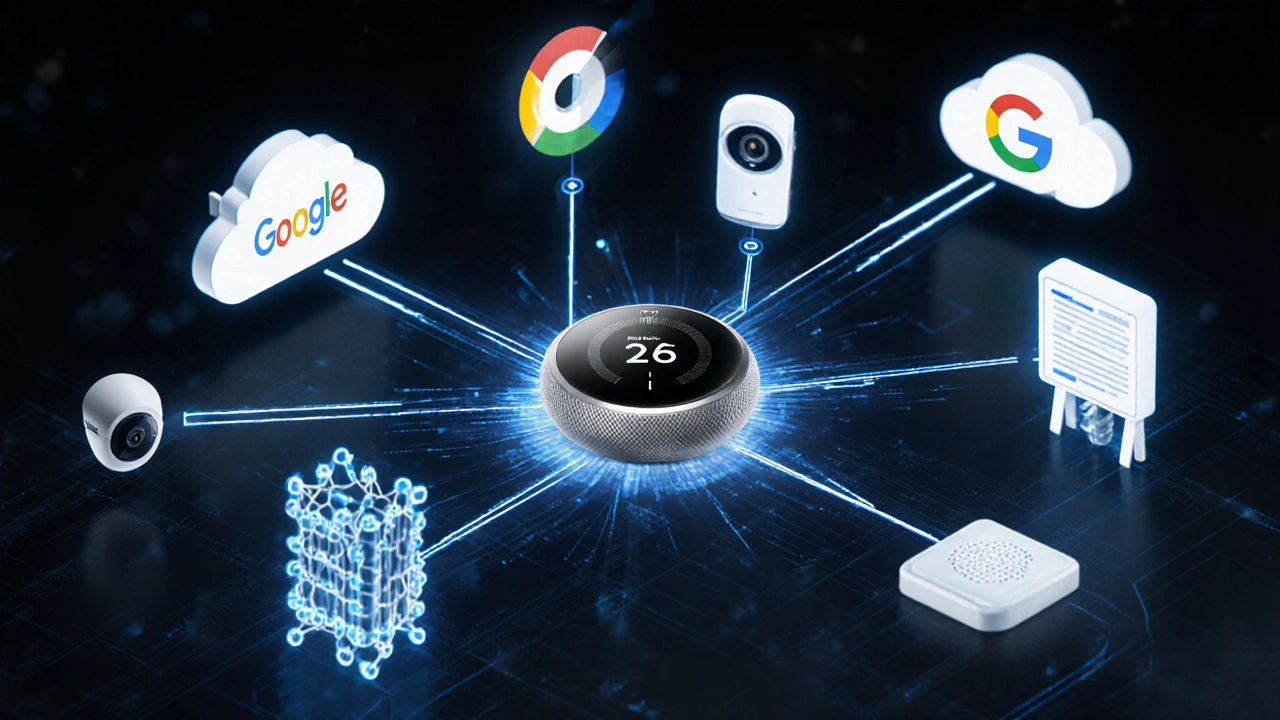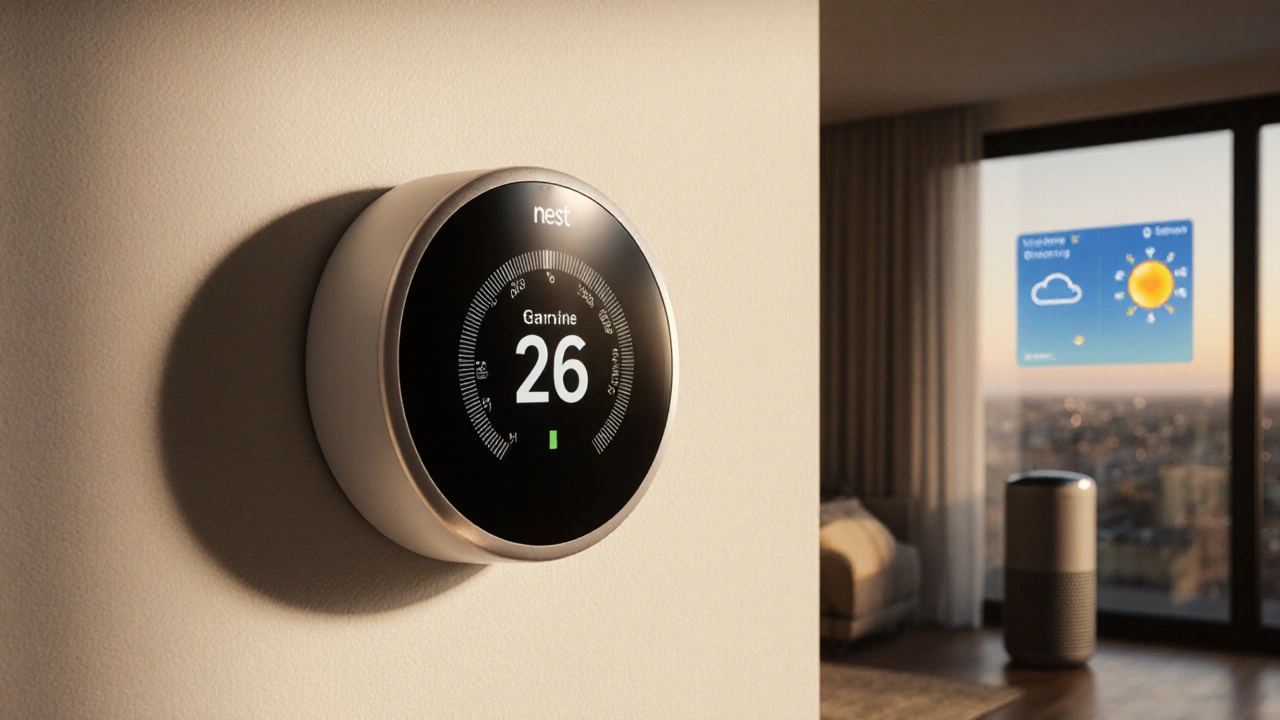When you walk into a modern home and see a sleek, learning thermostat adjusting the temperature on its own, chances are it’s a Nest. But if you’ve ever wondered who actually owns it, you’re not alone. The simple question - Is Nest owned by Google? - pops up often, especially as Google keeps rolling out new Nest products under its own name. The answer isn’t just yes or no. It’s a story of acquisition, rebranding, and how one company’s smart home vision got folded into a tech giant’s bigger plan.
How Nest became part of Google
Nest Labs was founded in 2010 by Tony Fadell and Matt Rogers, two former Apple engineers who wanted to make home devices smarter - not just connected, but intuitive. Their first product, the Nest Learning Thermostat, didn’t just let you control temperature from your phone. It learned your schedule, turned itself down when no one was home, and even showed you how much energy you saved. It looked like a piece of modern art. People loved it. So did Google.
In January 2014, Google announced it was buying Nest for $3.2 billion. That was a massive price tag for a company that had sold just over a million thermostats and a handful of smoke detectors at the time. Critics called it overpaying. But Google saw something deeper: Nest wasn’t just a thermostat company. It was a gateway to the home. Every device Nest made collected data about how people lived - when they woke up, when they left, how they used heat and light. That data was gold for Google’s long-term vision of an intelligent home ecosystem.
What happened after the acquisition?
At first, Nest kept its own brand, team, and office in Palo Alto. Google let it operate like a startup. That changed over time. By 2016, Google started integrating Nest’s software with its own services. The Nest app began syncing with Google Assistant. Thermostats started showing weather forecasts pulled from Google’s servers. Smoke alarms started sending alerts to your Android phone via Google Cloud.
Then came the big shift in 2018. Google quietly began rebranding Nest products under the name “Google Nest.” The Nest Thermostat became the Google Nest Thermostat. The Nest Cam became the Google Nest Cam. Even the Nest Hub smart display got the new label. The Nest brand didn’t disappear overnight - it just faded into the background. Today, if you buy a new smart thermostat from Google, it says “Nest” on the device, but everything else - the app, the voice commands, the account setup - runs through Google.
Is Nest still a separate company?
No. Nest Labs as an independent entity no longer exists. It’s fully absorbed into Google’s hardware division, which also handles Pixel phones, Chromecast, and Google Home speakers. The original Nest team has mostly moved on. Tony Fadell left in 2016. Matt Rogers followed in 2017. The people still working on Nest products today are Google employees, working out of Google’s offices in Mountain View and other global hubs.
That doesn’t mean Nest’s design DNA disappeared. The minimalist look, the smooth rotation dial, the way it learns your habits - those are still core to every new Nest device. But now, they’re built on Google’s infrastructure. The thermostat doesn’t just learn your schedule - it uses Google’s machine learning models trained on millions of homes. The doorbell camera doesn’t just detect motion - it uses Google’s AI to tell if it’s a person, a pet, or a car passing by.

Why does this matter to you?
If you own a Nest device, you’re already using Google’s ecosystem - whether you realize it or not. Your thermostat data is stored on Google servers. Your camera footage is uploaded to Google Cloud. Your voice commands go through Google Assistant. Even if you don’t use a Google Pixel phone or Gmail, your Nest device is tied to your Google account.
That has real implications. For example:
- If you delete your Google account, your Nest devices stop working.
- If Google changes its privacy policy, your home data policy changes too.
- If you want to use Alexa instead of Google Assistant, you can’t fully control your Nest devices with Amazon’s system.
Some people like that integration. They like being able to say, “Hey Google, turn down the heat,” and have it happen instantly. Others worry about giving one company so much control over their home. There’s no right answer - but knowing the truth helps you make better choices.
What’s the difference between Nest and Google Nest?
It’s mostly branding. The physical devices are nearly identical. A Nest Thermostat E from 2019 and a Google Nest Thermostat E from 2023 look the same. They have the same sensors, the same learning features, the same Wi-Fi chip. The only real difference is the software behind them.
Post-2018 devices get updates faster. They support more Google Assistant features. They can integrate with other Google hardware like the Nest Doorbell or Nest Audio. Older Nest devices still work, but they’re stuck on the old software. Google stopped pushing major updates to non-Google-branded Nest products after 2020.
If you’re buying a new thermostat today, you’re getting a Google Nest product - even if the box says “Nest.” The brand name is just a legacy label. The engine? That’s all Google.

What does this mean for the future of smart homes?
Google’s ownership of Nest didn’t just give it a thermostat. It gave it a foothold in every room of the house. Today, Google Nest includes thermostats, doorbells, cameras, speakers, displays, and even security systems. All of them talk to each other. All of them link to your Google account. All of them feed data into Google’s AI.
That’s why Nest is still around - not because it’s a standalone brand, but because it’s the most trusted name in smart home hardware. Google didn’t kill Nest. It turned it into the face of its smart home strategy. And that strategy is growing fast. In 2024, Google reported over 50 million active Nest devices worldwide. That’s more than all of Amazon’s Echo devices combined in the smart thermostat category.
The real question isn’t whether Nest is owned by Google. It’s whether you’re comfortable letting Google run your home - one learned temperature setting, one motion detection, one voice command at a time.
Can you still buy a non-Google Nest device?
No. Since 2021, all new Nest-branded products are manufactured and sold under Google’s control. Even refurbished units sold by Google are rebranded as Google Nest. Third-party sellers might still list older Nest models, but those are leftovers from before the rebrand. They won’t get new features or security updates beyond what Google has already released.
If you want a smart thermostat that’s not tied to Google, you’ll need to look elsewhere. Brands like Ecobee, Honeywell, or Mitsubishi offer similar features without forcing you into Google’s ecosystem. But if you already have a Nest device, you’re locked in - unless you’re willing to replace it.


Bharat Patel
November 24, 2025 AT 13:29It's wild how we let companies like Google walk into our homes like they're invited guests. Nest made us feel like we were getting something beautiful and smart, but really we were handing over the keys to our daily rhythms. The warmth of our homes, the quiet of our nights - now all just data points in some algorithm's training set. I don't hate it, but I wonder if we ever paused to ask whether we really wanted this kind of intimacy with a corporation.
Bhagyashri Zokarkar
November 25, 2025 AT 12:17so like… google just stole our homes?? like literally?? my nest just turned off the heat at 3am last week and i was like wtf and then i realized it ‘learned’ i was out but i wasnt out i was just sleeping and now it thinks i like 16c?? its like a robot stalker with a degree in thermodynamics
Rakesh Dorwal
November 25, 2025 AT 17:01Of course Google owns it. You think they spent $3.2 billion on a thermostat? That’s just the tip. Every temperature change, every time you leave the house, every voice command - it’s all feeding into AI that’s being trained to predict how Indians live. And don’t even get me started on how this connects to the U.S. surveillance state. We’re not just buying devices - we’re buying into a global data empire. Wake up, people.
Vishal Gaur
November 26, 2025 AT 00:43i had a nest for like 4 years and it was cool until one day it just stopped working right and i had to reset it like 5 times and then i realized i couldnt even use it without being logged into google and i was like man i just wanted a thermostat not a google account manager. also the app is trash and the updates make it worse every time. why do they even bother?
Nikhil Gavhane
November 27, 2025 AT 11:25I think the real win here is that Nest made smart homes feel human. Even though it’s all Google now, the design still feels thoughtful - like someone cared about how it fit into your life, not just how it could collect data. I still love mine. It’s not perfect, but it’s warm in the morning and cool at night, just like it should be. Maybe that’s enough.
Rajat Patil
November 28, 2025 AT 18:06It is important to understand that when we choose a product, we also choose the ecosystem it belongs to. Nest was a brand that offered simplicity and elegance. Google has continued that tradition, while adding deeper integration. This is not necessarily bad. It is simply the direction of technology. We must accept the trade-offs and make informed decisions.
deepak srinivasa
November 30, 2025 AT 11:31If Google owns Nest, does that mean my thermostat knows when I’m sad? Like, if I keep the house colder than usual for days, does it flag that as ‘possible depression’ and send a report to some team? I mean… I know it tracks habits, but how far does that go? Is my loneliness now a data point?
pk Pk
November 30, 2025 AT 18:33Look, if you’re worried about Google owning your thermostat, you’re missing the bigger picture. The real power isn’t in the device - it’s in what you do with it. If you want privacy, use Ecobee. If you want convenience and integration, stick with Nest. Don’t fear the tech. Learn how to use it on your terms. You’re not powerless - you just need to be informed.
Shivani Vaidya
November 30, 2025 AT 23:46I appreciate how Nest kept the design minimal even after Google took over. The dial, the silence, the way it glows softly at night - that’s still the soul of the product. I think Google respected that enough to preserve it. Maybe that’s the quiet victory here: not everything had to change to be improved.
Rubina Jadhav
December 2, 2025 AT 05:51I just want my house to be warm when I get home. I don’t care who owns the thermostat. As long as it works, I’m happy.